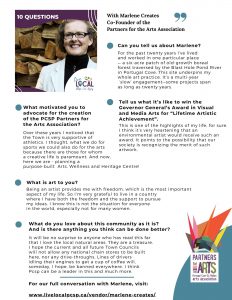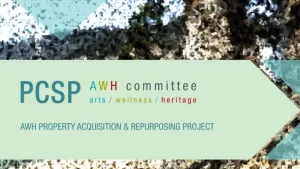Thank you to Marlene Creates for participating in the August 2022 PCSP Member Voice & Guide!
“When I grow up I think I want to be an artist and paint pictures. After I paint
the pictures I will give them to the stores and the people would give the money to
me for the pictures. I would visit schools and I might teach art lessons on Saturday.
Maybe I might visit other countries and get different scenes. I would visit England and paint the Ivory Tower.
(I think that I had heard of the iconic Eiffel Tower, the Tower of London, and
the white marble Taj Mahal, but I have no idea how I had heard of the ivory
tower—which is not a real tower but a metaphorical place where people live in a
world of ideas. Somehow, I had blended all these towers together.
Well, I didn’t turn out to be a painter after all. But I’ve always thought that being
an artist meant having the freedom to go somewhere and look at the world. My
artworks don’t come from my imagination but from paying attention to what’s
already there. I don’t think the world needs me to add anything to it from my
imagination. I call myself an environmental artist and poet. Underlying all my work is an interest
in place—not as a geographical location but as a process that involves memory,
multiple narratives, ecology, and language. I feel we are shaped by our
surroundings—the kind of terrain and vegetation, the seasons, the light, the natural
sounds, and the water in its myriad forms. My work is a result of my curiosity about our
relationship to place, as well as my love of experiences in the natural world because
they make my life more vivid. For the past twenty years I’ve lived and worked in one particular place—a six-acre
patch of old-growth boreal forest traversed by the Blast Hole Pond River
in Portugal Cove. This site underpins my whole art practice. It’s a multi-year ‘slow’
engagement—some projects span as long as twenty years. I try to avoid using the word ‘property’ for this patch of boreal forest. I’m just the
guardian of this place for a period of time. The idea of “owning” the volcanic formation
behind my house that’s over 650 million years old—hundreds of millions of years
before human life evolved—seems absurd.For that matter, I don’t think I can own atree, which is its own being and connected to all the other beings around and under it. My artwork is about being just one being amongst many others.
Q: Tell us what it’s like to win the Governor General’s Award in Visual and
Media Arts for “Lifetime Artistic Achievement”.
A: This is one of the highlights of my life, for sure. I think it’s very heartening that an
environmental artist would receive such an award. It points to the possibility that
our society is recognizing the merit of such artwork.
Q: What motivated you to advocate for the creation of the PCSP Partners for
the Arts Association?
A: I’ve lived in Portugal Cove-St. Philip’s for 20 years now. Over these years I
noticed that the Town is very supportive of athletics. There are multiple sports and
recreation facilities (soccer fields, softball diamonds, basketball courts,
playgrounds, and a skateboard park), sporting events, pictures of teams on the front
page of the Town’s newsletter, and numerous awards for coaches, teams, and
individual athletes in the “Best of PCSP Community Awards”. The story of the arts association starts at the PCSP Chamber of Commerce
Christmas Gathering at Wild Horses on December 11, 2019. I happened to sit at the bar beside Michael Murray and, while we were separating the 50-50 tickets,
Michael turned and asked me, “What can the Chamber do for the artists in Portugal Cove-St. Philip’s?”
Wow! I hardly knew where to start. We did start—by holding a public meeting just a few weeks later, on January 27, 2020, to hear from the creative people in PCSP about what is on their wish lists. Most of the members on the volunteer steering committee for Partners for the Arts stepped up at that meeting, and we have continued on as volunteers on the Arts, Wellness & Heritage (AWH) ad hoc committee of the PCSP Chamber of Commerce. Now here we are—planning a new purpose-built Arts, Wellness, and Heritage Centre!
Q: As a member of the Arts, Wellness & Heritage (AHW) Committee, what do
you hope to champion and accomplish within the cultural centre it will be
building in PCSP?
Our ambition is to create an inclusive, multi-use centre for people of all ages and
demographics. It would fulfill the following needs in the community: a multi-use
space for performance (music, dance, theatre), films, talks, receptions, readings
and book launches for the literary arts; exhibition space for art, crafts, and local
history displays; workshop space for hands-on learning and professional
development; and a place of healing. This centre will enrich our lives by presenting the heritage of Portugal Cove-
St. Philip’s, fostering creativity by residents of all ages, and providing a space forhealth, wellness, and mindfulness.
This centre will be a crucial strategic investment in our community’s well-being.
I would like to express my deep thanks to the PCSP Chamber of Commerce
who have recognized the importance of the arts in our lives and been extremely
supportive of this initiative.
Q: What is your preferred medium? And have you experimented or tried other
mediums?
A: I’m not a studio artist. I work outside and my “studio” is the land and the water.
When I first left art school, I thought that to be an artist I needed to have a studio in
which to make things. I struggled with this for a few years until I started working
outside directly in the landscape, making temporary sculptures that I photographed.
I worked on this series, titled Paper, Stones and Water, between 1979–1985 in
various remote areas in the UK and Canada. My artwork for more than 40 years
has flowed from that stepping away from a studio in order to work outside with the
elements, the seasons, and the weather. I often use photography or video.
For 15 years I also presented multidisciplinary poetry walks in this patch of
boreal forest in Portugal Cove, which I call The Boreal Poetry Garden. On these
walks I read my site-specific poems, and I’ve invited many others to contribute
their expertise to these events: natural scientists, acoustic musicians, contemporary
dancers, and other poets. Over 900 visitors have come to these events.
I’m a believer in ripple effects—we don’t know where they spread out to because
that information rarely comes back to us. But I’ve been told that my work has helped
some people become more aware of the environment. I couldn’t ask for more.
Q: How do you feel your heritage and life experiences influenced your art?
And your view on art?
Although I was born and grew up in Montreal, my family history includes
Newfoundland—my mother’s parents (my maternal grandparents) were born in
Lewisporte, and my great-grandparents and several generations previous to them
were from Fogo Island. Their ancestors came to Fogo Island from Dorset and Devon
in England. My curiosity about my family history is the main reason I came to
Newfoundland. The island’s rich, multi-faceted culture and shimmering natural
environment have provided me with an abundance of material for my artwork.
My paternal family history is also in England—my father’s parents were
born in London.From what I know of both branches of my family history, my ancestors came to
this continent to make better lives for themselves because they were very poor, landless
people locked in the rigid British class system. (Still, the ones who settled on Fogo
Island became poor fisher people. My paternal family history is also in England—my father’s parents were
born in London.From what I know of both branches of my family history, my ancestors came to
this continent to make better lives for themselves because they were very poor, landless
people locked in the rigid British class system. (Still, the ones who settled on Fogo
Island became poor fisher people.) I’m descended from settlers but, from my point of
view, they came as refugees.Yet, no matter who we are or how we have come to be here, the land, the air, the
water, and what’s underneath—these are not gendered or nationalized. They’re not of
any one race or creed or culture. We breathe the same air; we are all of the land and the
water. I hope we can all work together openly, transparently, with acceptance, sharing,
inclusion, good will, and respect in order to move forward using different ways of
knowing.
Q: What is art to you?
A: I believe artists can lead the way for change. The work I see by other artists in every
discipline—the performing, literary, and visual arts—contributes to my
understanding of the world. Being an artist provides me with freedom, which is the most important
aspect of my life. So I’m very grateful to live in a country where I have both the
freedom and the support to pursue my ideas. I know this is not the situation for
everyone in the world, especially not for many women.
Q: What do you feel is something people in our community can actively do to
reduce our personal footprint?
A: It sometimes seems to me that we don’t value our trees as much as we should. Clear-cutting the natural boreal forest and, without question, replacing it with lawns seems like wishing Portugal Cove-St. Philip’s was like a suburban subdivision on the mainland. Trees are essential to life on Earth—they absorb carbon (from the carbon dioxide causing global warming), with which they create their bodies, what we know as ‘wood’. And they off-gas the oxygen, which we humans and all other creatures need to breathe. Lawns are mono-cultures that require much in the way of water resources, toxic herbicides, fertilizers, and fossil fuels to power noisy lawn mowers. Natural ground cover, with its mosses and wildflowers, cannot be improved upon; does not require any maintenance; and contributes to the ecosystem and its pollinators.
Q: What do you love about this community as it is? And is there anything you
think we can do better?
A: It will be no surprise to anyone who has read this far that I love the local natural
areas. They are a treasure. After that, I would say the local businesses are the town’s greatest asset.
I rarely need to go into St. John’s for anything anymore. But for those who do have
to commute, some public transportation would be an improvement I hope the current and all future Town Councils will not allow any national
chain stores to be built here, nor any drive-throughs. Lines of drivers idling their engines to get a cup of coffee will, someday, I hope, be banned everywhere. I think Portugal Cove-St. Philip’s can be a leader in this … and much more.


